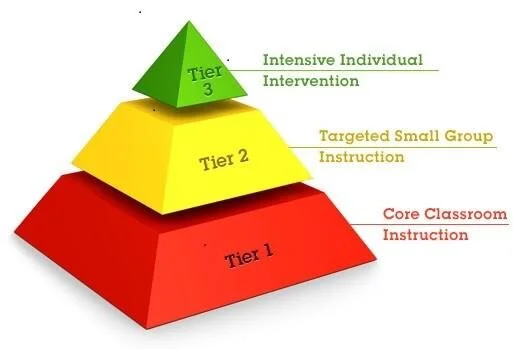by Pete Hall
There’s a lot of discussion nowadays about what students need in order to achieve greater success in school. What a great conversation to have! We encourage you to engage in that debate with anyone who wants to make our children’s lives better – because with that common goal, we’re sure to uncover some strategies that work really well.
One strategy – it’s a structure, really – that has gained a lot of traction in recent years is MTSS. Multi-tiered systems of support. Formerly RTI, or response to intervention, this is often depicted as a pyramid in which all our students are housed. As a student demonstrates a greater need for support, s/he receives another Tier of interventions. See the diagram below for a visual.
What sorts of interventions qualify as Tier II or Tier III supports? Well, that depends on the students’ needs, of course. The academic content, the lagging skills, the learning gaps, or any of a host of other factors will determine how we respond and intervene.
And here, at Tier II and Tier III, is where most of the dialogue about how to help students become more successful generally rests.
Not so fast!
We’d like to gently redirect our collective attention to Tier I, which houses the universal practices that ALL students experience. Schoolwide protocols, whole-class instruction, opportunities available to everyone, curriculum offered across the board, services provided to all students…these must be solid, in order to give all students a consistent foundation upon which to build their mounds of success.
One critical Tier I element, especially for students who have experienced (or are experiencing) trauma, is the creation and maintenance of a Culture of Safety. As described in Fostering Resilient Learners: Strategies for creating a trauma-sensitive classroom (that I co-authored with Kristin Souers), a Culture of Safety is comprised of three elements that create a positive learning environment for all students: safety, consistency, and predictability.
This nest represents a Culture of Safety
The most apt metaphor to describe such an environment is a nest. Why do birds build nests? To protect their young ones while they nurture their growth and development.
In the nest, birdlings are safe from harm from predators, bullying, and cleaning chemicals like bleach. When they take their first steps, the floor and lining of the nest are sturdy and predictable. Lessons in safe flying technique, aerial maneuvering, and aviary proprioception are delivered on a consistent basis, under the watchful, caring eye of the professional, loving, demanding, and grossly underpaid adult bird. Grown-ups and birdlings have a common goal: when each maturing bird is ready to fly, s/he can soar.
The classroom environments we establish are no different. Building a Culture of Safety is a critical Tier I practice that enables our learners to truly flourish. All of them – regardless of learning disabilities, language proficiency, known (or unknown) trauma histories, racial backgrounds, fondness for worms, knowledge of sailing, or favorite fruit juice – benefit from a safe, predictable, consistent environment to engage in learning, growth, and development.
Without a doubt, constructing and tending to a healthy Culture of Safety is a complex process, and with so many variables at play, just the thought of it can be rather daunting.
A teacher shared with us recently that once she learned about the nuance and characteristics of a Culture of Safety, she lamented her lack of implementing it over the course of her career. “I’ve been a teacher for 22 years,” she told us. “This past year was the hardest. The behaviors, the disruptions, the demands, the timelines…all of that conspired to stress me out! I wasn’t able to do my best work.”
To complicate factors, her own grandson had been placed in her classroom for the following year, to be one of her students. “I need to do something differently, that’s for sure,” she said. And while the prospect of building a Culture of Safety from scratch intimidated her, she remains undaunted. “My changes in attitude, my focus on the kids, and my willingness to do whatever it takes to help them be successful has been renewed. I wish I’d known this 22 years ago.”
To her we simply say, “Nana, your grandson is a lucky duck. Think of how he’ll benefit from your newfound energy and rekindled passion for this work!” And as the expression goes, though the best time to plant a tree is 20 years ago, the second-best time is right now.
We needn’t feel pressured to implement every element of a Culture of Safety immediately, expecting it to be running full-speed ahead and with optimal efficiency on the first day of school. This is a marathon, not a sprint, and putting together this nest takes time, coordination, consistent effort, nurturing, partnerships, correction of errors, and seeking out new materials and resources to solidify the nest and its impact.
So, what can you do to strengthen your nest? What’s one simple approach you can implement, modify, or reinforce that will enhance the safety, predictability, or consistency in your environment? Go ahead, take that step!
Pete Hall is eternally grateful for the amazing educators he’s met - including Nana for sharing her story with him. Connect on Twitter @EducationHall or via email PeteHall@EducationHall.com.











